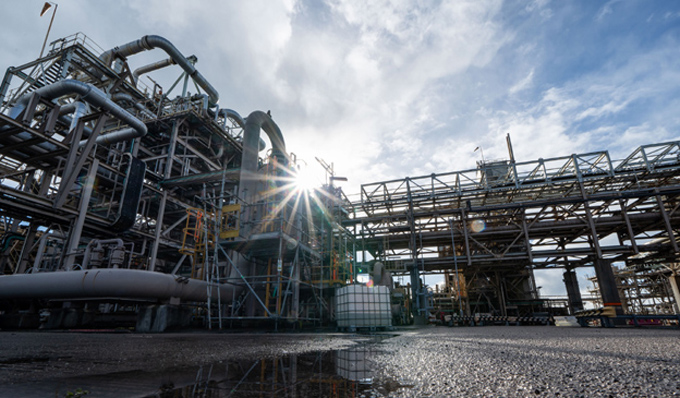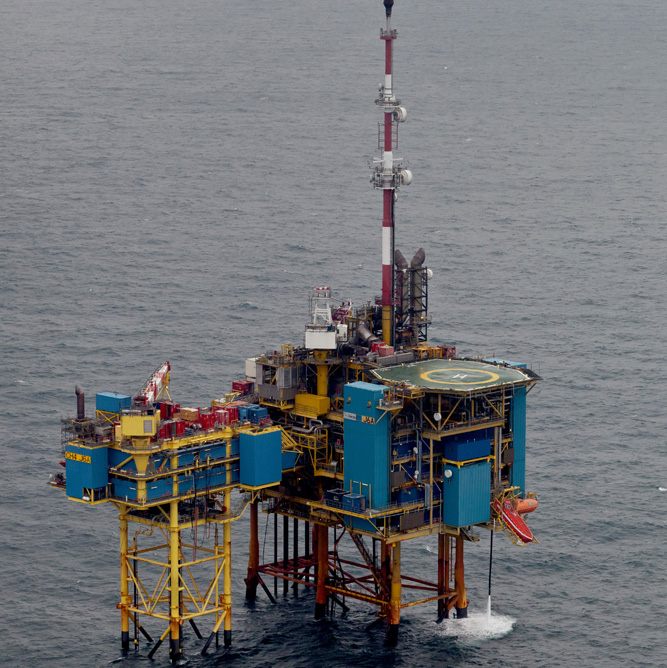
Spirit Energy was created in 2017 following the combination of Centrica’s Exploration & Production business and Bayerngas Norge AS. The business is 69%-owned by Centrica plc, with the remaining 31% owned by Bayerngas Norge’s former shareholders, led by Stadtwerke München and Bayerngas GmbH.
The formation of Spirit Energy creates a strong and sustainable European E&P business, combining Centrica’s cash-generative and relatively near-term production profile with Bayerngas Norge’s more recently on-stream producing assets and development portfolio.
Overview of Operations

United Kingdom
Spirit Energy's experience stretches back 40 years, starting with the gas fields in Morecambe Bay, which remain a key part of the Company's operations.
Today, the UK teams produce oil and gas from operated and non-operated fields - from Morecambe CPC in the East Irish Sea to Cygnus in the southern North Sea.
Eris and Ceres
Operated
Eris and Ceres are single-well subsea tiebacks located approximately 34km and 44km, respectively, east of the Easington Gas Terminal in the Southern North Sea. Eris sits in block 47/8c-4 at a water depth of 41m, and Ceres in 47/9c-11 at a water depth of 29m.
Both export through the Mercury subsea manifold and then flow via Neptune to Cleeton and the Dimlington onshore terminal. Production commenced in 2010, with an expected field life of mid-to-late 2020s.
Morecambe Hub
Operated
The Morecambe Hub comprises three fields in the East Irish Sea - North Morecambe, South Morecambe and Rhyl. The fields lie approximately 25km south west of Walney Island, across blocks 110/2a, 110/3a, 110/8a and 113/27b, in water depths that range from 17 to 35m.
One of the largest gas fields in the UKCS, at its peak, the Morecambe Hub met 20% of the UK’s domestic gas demand. Despite being in production for almost 40 years, the Morecambe Hub remains a cornerstone operated asset in the Spirit Energy portfolio with the aim to produce to the end of the decade.
South Morecambe was discovered in 1974 and was the first to be developed, with production starting in 1985. The field has been developed using seven fixed jacket platforms, including the three-platform manned Central Processing Complex (CPC), four Normally Unmanned Installations (NUIs) and 36 development wells. Gas is exported via a 36” dedicated pipeline to the Barrow Gas Terminals. North Morecambe was discovered in 1976, with first gas in 1994. The development includes the normally unmanned DPPA platform which acts as the main gathering hub for the area, 10 development wells and a 12” pipeline to the Barrow Gas Terminals. Rhyl, which is north of the North Morecambe field, was discovered in 2009 and brought into production in March 2013. It has been developed as a two-well subsea tieback to DPPA.
Gas from all the fields is processed at Barrow Gas Terminals, which is located near Barrow-in-Furness in Cumbria, before entry into the National Transmission System. Spirit Energy’s offshore facilities and onshore terminal also provides gathering and processing services for third parties.
Morecambe Net Zero (MNZ) project
Spirit Energy has reached a major milestone for its Morecambe Net Zero (MNZ) project with the successful securing of a seismic survey vessel to undertake a scope of work in the East Irish Sea as the company continues its journey to net zero.
This reaffirms Spirit Energy's commitment towards a low carbon future for its operations as it continues to work towards transitioning its existing operations and strengthens its position as an energy transition business.
The survey will acquire and process around 500 square kilometres of high-resolution 3D seismic data over the Morecambe Bay gas fields to provide the detailed definition of the potential carbon storage sites. The survey fulfils a requirement on the recently awarded carbon storage licence, and the data acquired will support all subsequent models and mapping for Carbon Capture and Storage (CCS) initiatives.

Alba
Non-Operated
The Alba field lies about 130 miles northeast of Aberdeen in the Central North Sea, in block 16/26, in a water depth of approximately 138 metres.
Discovered in 1984, Alba is a heavy oil field and one of the first shallow Eocene reservoirs successfully developed in the North Sea. First oil was achieved in January 1994, and the field is now in late-life operations, with preparations underway for cessation of production (CoP) and eventual decommissioning.
The field’s infrastructure includes the fixed-jacket Alba North Platform (ANP), with a dry tree well bay, drilling package, and three-phase processing facilities. In 2001, the field was further developed with the addition of the Alba Extreme South (AXS) subsea production and injection system, which is tied back to the ANP. Oil from the field is exported to the Alba Floating Storage Unit (FSU), a permanent installation located within the field.
Brae
Non-Operated
The Brae Area lies approximately 170 miles northeast of Aberdeen, at a water depth of approximately 110m. The field was originally developed with three fixed jacket platforms—Alpha, Bravo, and East Brae—supporting the wider area, which consisted of North, South, East, and West Brae; Beinn, Braemar, and Kingfisher; the Spirit Energy-operated Trees field; and various third parties tied in.
Brae Alpha commenced production in 1983, Brae Bravo in 1988 and East Brae in 1993. The Central and West Brae/Sedgwick subsea tiebacks to Brae Alpha commenced production in 1989 and 1997, respectively, while the Braemar subsea tieback to East Brae commenced in 2003.
Brae Bravo reached Cessation of Production in 2018, with plug and abandonment, topsides, and upper jacket removal completed. East Brae native wells reached a CoP in June 2024, and Braemar's CoP is expected in early 2025. Brae Alpha is expected to reach CoP in early 2027.
Liquids from the Brae area are exported via the Ineos-operated Forties Pipeline, and gas is transported via the Scottish Area Gas Evacuation (SAGE) pipeline to St Fergus.
Clipper South
Non-Operated
Clipper South is a tight gas field in blocks 48/19 and 48/20 in the Southern North Sea, approximately 100 km east of the Lincolnshire coast. Situated in water depths ranging from 22 m to 26 m, it lies south of the Galleon and Ensign fields. The field's production comes from four long, horizontal, multi-fractured wells tied to a Not Permanently Attended Installation (NPAI).
In 2018, a new pipeline, subsea infrastructure, and processing equipment was installed, allowing production from the Clipper South field to be rerouted to the Clipper platform and onward to the Bacton Gas Terminal on the North Norfolk coast. Clipper South is a relatively young asset with significant remaining reserves, ensuring its continued contribution to the region's gas supply.
Cygnus
Non-Operated

The Cygnus Field is located in the Southern North Sea in blocks 44/11a and 44/12a, approximately 12km north of the Munro Field and 15km northwest of the Tyne Field. Water depth in this location ranges from between 15 to 25 metres.
The Cygnus infrastructure consists of three bridge-linked Alpha platforms, including a wellhead drilling centre (AWHP), a processing/utilities unit (APU) and the living quarters/central control room (AQU). The Bravo wellhead platform, a Not Permanently Attended Installation (NPAI), is located approximately 7km northwest of Cygnus Alpha. Gas and condensate are exported from the Alpha PU platform to the Bacton Gas Terminal. Cygnus gas is blended with a high Wobbe Index gas in Bacton to achieve National Grid entry specification. Two new wells were successfully drilled in 2022/23, with two further development wells sanctioned, with the first gas expected in 2025 and 2026, respectively.
First production from Cygnus was on 13 December 2016 (Alpha) and 1 August 2017 (Bravo), with the Cygnus Area expected to provide economic production potential beyond 2030.
Davy East
Non-Operated
Davy East is a subsea well located in block 53/5b in the Southern North Sea at a water depth of 41m. It lies 5km southeast of the Perenco-operated Davy platform, which has an established export route to the Indefatigable Field and the Bacton Gas Terminal on the North Sea coast of North Norfolk.
Galleon
Non-Operated
Galleon is located in block 48/20 in the Southern North Sea, east of Clipper and west of Audrey in the Sole Pit Area, at a water depth of 28m. It consists of 18 horizontal wells that produce gas via two unmanned platforms - PN and PG. Gas from Galleon is exported through the Clipper platform and transported to the Bacton Gas Terminal on the North Norfolk coast.
First production from Galleon began in 1994, and the field has a long production profile with substantial remaining reserves, ensuring its continued role in supporting the region's gas supply.
Netherlands
Spirit Energy operate one of the Dutch North Sea's key hubs, the Greater Markham Area, which has been producing gas for more than 30 years. It includes the Markham, Chiswick, Grove and Kew fields.
A key focus for our Netherlands team has been to introduce new technology and drill additional wells to maximise output from the region.
Greater Markham Area
Operated

The Greater Markham Area (GMA) hub spans both the UK and Dutch Continental Shelves, and comprises of the Spirit Energy-operated Markham, Chiswick, Grove and Kew fields, along with the Total Energies operated J3C, K1a, nd K4aD fields. Gas from all of these fields are processed across the Spirit Energy operated J6A platform and exported via the 160km long WGT pipeline system to the Den Helder onshore terminal, where it undergoes separation, conditioning, and distribution.
The J6A platform, a six-legged steel jacket structure installed in 1991, was originally designed to produce gas from the Markham field, in which Spirit holds a 37.5% equity interest. Production from the Markham field began in 1992, and in 2006, a compression tower was added to the west of J6A to support low-pressure gas compression. With no further production anticipated from Markham, the J6A platform now serves as a processing hub for gas from the neighbouring Chiswick, Grove, Kew, J3C, K1a, and K4aD fields.
Spirit holds a 100% equity interest in both the Chiswick and Kew fields, which were brought online in 2007 and 2013, respectively. Gas from these fields is commingled at the Spirit-operated Chiswick Normally Unmanned Installation (NUI) and transported to the J6A platform via an 18 km, 10-inch pipeline.
Similarly, the Grove field, where Spirit holds a 92.5% equity interest, also commenced production in 2007. Gas from Grove is commingled at the Spirit-operated Grove NUI and sent to the J6A platform through a 14 km, 10-inch pipeline.
LEADERSHIP
NEIL MCCULLOCH Chief Executive Officer
NICK HARRISON CFO
GIRISH KABRA Asset Director North Sea & Netherlands
SCOTT MCGINIGAL Technical Services & HSES Director
FAYE FLETCHER HR & Facilities Director
PETER HEPBURN Asset Director Morecambe
MATT BROWELL-HOOK Energy Transition Director
LOCATIONS
Spirit Energy - Aberdeen
iQ building, 15 Justice Mill Lane
Aberdeen AB11 6EQ
Tel: +44 (0)1224 415000
Spirit Energy - Barrow, UK
Rampside Road
Barrow-in-Furness
LA13 0QU
Tel: +44 (0)1229 822222
Spirit Energy Limited
Millstream, Maidenhead Road
Windsor SL4 5GD
Tel: +44 (0)1753 494000
KeyFacts Energy: Spirit Energy UK country profile l Spirit Energy Netherlands country profile
 KEYFACT Energy
KEYFACT Energy